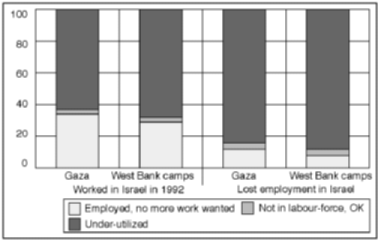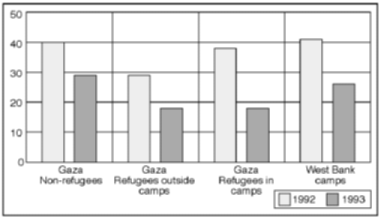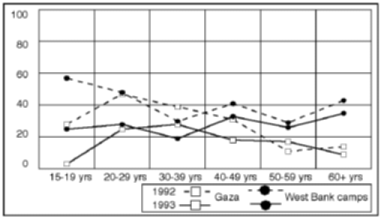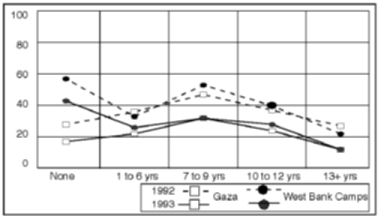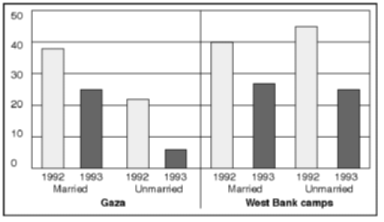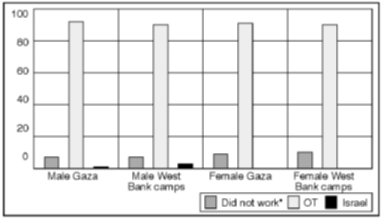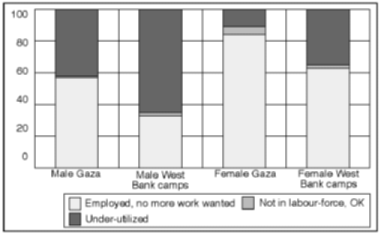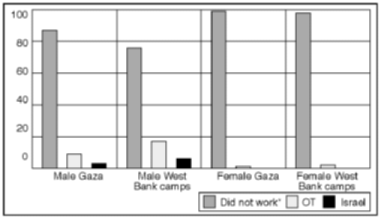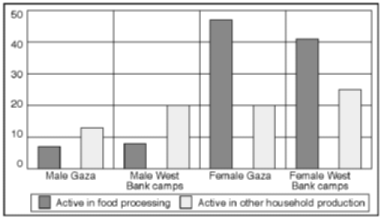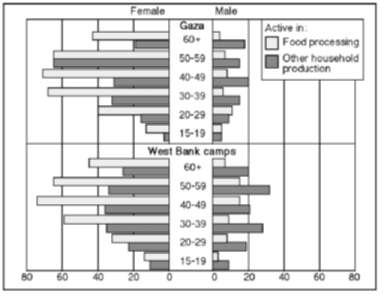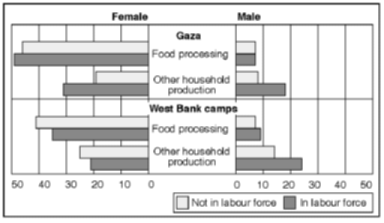
|
|
(Chapter 2) Employment patterns We begin this section by following changes in the employment situation of individuals in the sample from 1992 to 1993. Here we are particularly interested in the direct and indirect employment effects of the border closure. Did the workers who lost their jobs in Israel from 1992 to 1993 come from any particular type of locality? Were persons with any particular individual characteristics more affected than others? The earlier section about under-utilization of labour showed that only about a half of those who lost employment in Israel between 1992 and 1993 found new employment in the Occupied Territories. Did these workers "squeeze out" other workers? Are they content with their 1993 employment situation? The second aim of this section will be to look into the employment characteristics of workers who held jobs in 1993. By "employment characteristics" we here mean the distribution of workers according to types and sectors of work, as well as intensity of work, types of payment and status at the workplace. Many workers in our sample are still employed in Israel. Do those employed in Israel mainly perform unskilled, service and vocational work, as before? Are they predominantly employed in the construction, service and agricultural sectors? Do the 1993 employment characteristics vary by gender? Do employed women primarily hold low status jobs, and do they tend to work fewer hours than employed men? Finally, we will discuss individual engagement in household income-generating activities. Who works in household production? Is household production an alternative to "formal" labour activities? Changes in employment from 1992 to 1993 See tables 2.34 to 2.43 in appendix 3 as references to the discussion in this section. Initially the border closure was very comprehensive, preventing almost all Palestinian workers in Israel access to their jobs. Restrictions were then gradually relaxed. The Israelis still refused, however, to admit individuals considered to be "security threats". The loss of employment in Israel may be termed the "direct" employment effect of the border closure in March 1993. The loss of income from wages also led to adverse multiplicator effects on local demand and hence employment in the Occupied Territories. This effect may be termed the "indirect" employment effect of the border closure. Three main groups can be identified for further investigation as to the direct and indirect effects of the border closure, on the basis of the survey population's pre-closure employment status. The first group comprises persons who worked in Israel in 1992. The second group persons who worked in the Occupied Territories in 1992, and the third group persons not active in the labour market in 1992. Figures 2.12 and 2.13 present a comparison between the percentages of workers who worked mainly in Israel in October/November 1993, and the corresponding percentages for the same months in 1992. It seems reasonable to interpret the difference in employment percentages as the direct effect of the border closure. In both main survey areas there was a net reduction of employment in Israel of more than 1/3 since 1992. Our principal indicator for measuring the direct effects of the border closure is to take the group of workers who in 1992 were employed in Israel, and investigate their employment status and workplace, if any, in 1993. As can be seen from figure 2.30, this gross reduction of employment in Israel from autumn 1992 to autumn 1993 amounted to 50%. Only 1 out of 4 persons employed in Israel in 1992 started working in the Occupied Territories in 1993. Almost 2 out of 3 of those who had been working in Israel in 1992 expressed a desire for more work in 1993.
Figure 2.30 Main area of work in 1993 of those working in Israel in 1992,
by main geographical region of residence. Percentage of adults in respective groups Figure 2.31 presents results for the sub-group which lost employment in Israel. In Gaza only 1 out of 3 persons who lost their jobs in Israel between 1992 and 1993 found new employment in the Occupied Territories. In both areas more than 80% wanted to work more in 1993, the highest level found for any group.
Figure 2.31 Employment situation of those working in Israel in 1992,
by main geographical region of residence. Percentage of adults in respective groups Have workers who lost employment in Israel "squeezed out" other workers in local employment? The results do not support such a hypothesis. First, less than half of the workers previously employed in Israel found employment locally. Second, employment characteristics of these workers indicate a group of marginal workers, employed in low-status jobs with high instability and insecurity. We have noted that there was a net reduction of 1/3 among Palestinian workers in Israel from 1992 to 1993. Which socio-economic groups have been affected in particular six months after the border closure? To answer this question, we need a more detailed discussion of the net direct effects of the closure on various regions and socio-economic groups. Table 2.16 in the Labour table appendix showed that the areas most remote from Israeli population centres have the largest net reduction in employment in Israel. A possible explanation is that the new time-consuming security checks at the border crossings are most burdensome for workers with the longest travel distances. Figure 2.32 compares reduction in Gaza male employment in Israel by refugee status, using West Bank refugee camps as reference.
Figure 2.32 1993/1992 male employment in Israel, by refugee status. Percentage of adults
in respective groups employed one week or more during a four-week period prior to the
survey, (October/November 1993), and the corresponding period in 1992 Workers from the Gaza refugee camps seem to be the group most severely hit. In terms of the 1992 employment share in Israel, the net reduction of employment in Israel is 28% for Gaza non-refugees, 38% for Gaza refugees outside camps, and 53% for Gaza camp refugees. For the West Bank refugee camps the corresponding figure is 36%. Some of the substantial reduction for Gaza camp refugees may be accounted for by the over-representation of camp refugees in the remote Southern part of the Gaza Strip. Another possible explanation could be Israeli reluctance to those living in refugee camps in Gaza. The March 1993 employment restrictions were particularly targeted at young, unmarried men. As expected, figures 2.33, 2.34 and 2.35 show that the net reduction in employment in Israel is particularly marked for young, unmarried males with above average education.
Figure 2.33 Employed males who worked mainly in Israel, by main geographical area and age.
Percentage of males employed one week or more during a four-week period prior to the
survey, (October/November 1993), and the corresponding period in 1992
Figure 2.34 Employed males who worked mainly in Israel, by main geographical area and education.
Percentage of males employed one week or more during a four-week period prior to the
survey, (October/November 1993), and the corresponding period in 1992
Figure 2.35 Employed males who worked mainly in Israel, by main geographical area and marital status.
Percentage of males employed one week or more during a four-week period prior to the
survey, (October/November 1993), and the corresponding period in 1992 Even if the 20-29 and 30-39 age groups still are over-represented among Palestinian workers in Israel, variations by age are smaller in 1993 than in 1992. Regional comparisons of average age and years of education for workers employed in Israel in 1993 and 1992 show that the average age of workers employed in Israel has increased by 1.6 years in both main regions. The 1993 labour-force status and place of employment for workers who in 1992 were employed in the Occupied Territories illustrates the gross indirect employment effect of the border closure. Figure 2.36 shows that 9 out of 10 of those who had been employed in the Occupied Territories in 1992 were still working there in 1993. Measured in this way the indirect effects of the border closure seem to be limited.
Figure 2.36 Main area of work in 1993 for persons who worked in the OT or abroad
in 1992, by gender and main geographical area. Percentage of adults in respective groups As shown by figure 2.37, there is, however, a widespread desire for more work among men in this group, particularly in the West Bank refugee camps. This may reflect a substantial drop in income from local employment after the border closure.
Figure 2.37 Employment situation in 1993 for persons who worked in the OT or abroad
in 1992, by gender and main geographical area. Percentage of adults in respective groups We finally turn to the persons with no labour activities in 1992. Figure 2.38 shows that almost 90% of Gaza males who were inactive in 1992 remained so in 1993 as well. In the West Bank refugee camps 1 out of 4 males inactive in 1992 started working in 1993, mostly in the Occupied Territories. In both main geographical areas, more than 1 out of 3 males inactive in 1992 expressed a desire for more work in 1993.
Figure 2.38 Main area of work in 1993 for persons who did not work in 1992, by
gender and main geographical area. Percentage of adults in respective groups Almost all women who were inactive in 1992 remained so also in 1993. Few females expressed desire for work in 1993, particularly in Gaza. Male employment by main area of work See tables 2.44 to 2.52 in appendix 3 as references to the discussion in this section. Despite the almost 40% net reduction in employment in Israel from 1992 to 1993, 1 out of 4 employed men in the survey population were working in Israel in 1993. The FALCOT 92 report found that the vast majority of Palestinian workers in Israel perform unskilled, service and vocational work in the construction, service and agricultural sectors. Did this employment pattern still persist as of October/November 1993? 6 Despite the large reduction of workers, there appear to be no substantial changes in employment patterns in terms of type of work and sector for Palestinian workers in Israel between 1992 and 1993. Professional employment is almost non-existent. As much as 9 out of 10 of these workers, the same figure as in the FALCOT 92 report, perform unskilled, service or vocational work. Construction is the dominant sector, providing employment for over half the workers. Not surprisingly, job stability of Palestinians workers in Israel is found to be generally lower than for workers employed in the Occupied Territories. The same finding was noted in the FALCOT 92 report. A decrease in the number of working weeks, particularly concerning employment in Israel, was the only substantial change between 1993 and 1992 which was reported within the 1993 sample. Nor for Palestinian workers employed in the Occupied Territories can any substantial change in employment types and sectors be found. Approximately half of these workers perform unskilled, service or vocational work. In Gaza, however, this group seems to have increased in size compared to the FALCOT 92 report. Sub-contracting and piecework payment are widespread in the Occupied Territories. Among Palestinian workers employed in Israel, on the contrary, such arrangements are virtually non-existent. Instead these workers receive daily or weekly wages. Many enterprises in the Occupied Territories using sub-contracting or piecework are owned by Israelis or produce directly or indirectly for the Israeli market. In contrast to monthly wages, both sub-contracting/ piecework and daily/weekly wages are indicators of unstable and unpredictable employment for the workers involved. Workers from the Occupied Territories still employed in Israel face employment instability and uncertainty on three levels. First, borders may once again be completely closed with no previous warning. Second, more than half of these workers are employed in the construction sector, which is characterized by even greater cyclical fluctuations than in most other countries, due to immigration from the former Soviet Union. Third, the majority of workers in Israel receive daily wages, indicating short employment horizons, with constant risk of being ousted by other workers. Employment by gender and area of residence See tables 2.53 to 2.56 in appendix 3 as references to the discussion in this section. As in the FALCOT 92 report, the 1993 employment characteristics show large differences by gender but relatively small variations by area of residence. There are far more professional workers among women than among men; this is reflected both in the high share of female workers receiving wages on a monthly basis, and in the higher job stability for female than for male workers. The total number of employed women in the survey is too small for detailed comparisons by sector and type of work. Due to the community of (land-owning) non-refugees in Gaza, male employment in agriculture is higher in Gaza than in the West Bank refugee camps. The number of male unskilled and service workers in the West Bank refugee camps, by contrast, is almost twice as high as in Gaza. Because most West Bank refugee camps are situated close to urban areas with relatively high purchasing power, a reasonable explanation is that these workers serve adjacent towns. A breakdown of the results for Gaza men by refugee status and type of locality does not reveal any major differences in the average number of working weeks, status at the workplace or type of payment. There is some tendency towards lower work stability for camp refugees than for other groups in Gaza. As could be expected, the Gaza non-refugee community has a somewhat higher instance of (agriculture related) family labour, and a lower number of persons working for UNRWA. Individual engagement in income-generating household activities See tables 2.57 to 2.62 in appendix 3 as references to the discussion in this section. In the first part of this chapter, "income-generating household activities" were defined as activities that bring supplementary income to households. Such activities have both traditional and modern origins in the Occupied Territories. Historically, elderly women played a pivotal role, passing their knowledge and skills on to daughters and daughters-in-law. Even though many activities declined along with the process of modernization, the Intifada brought about a revival of income-generating household activities for political reasons, meant to reduce dependence on the Israeli economy, such income-generating activities symbolized the return to the land and rejection of Israeli dominance. This sub-section will focus on the employment aspect of such activities, to the extent responsibility for them can be ascribed to individual, adult members of a household. Their significance for the household economy, and changes since the border closure, will be discussed in the subsequent chapter regarding household economy. The proportion of households engaged in various income-generating household activities is, of course, higher than the corresponding figure for individuals. Except for poultry, crafts and in particular food processing, no activities are conducted by more than 5 per cent of the individuals in any area. To simplify the discussion, the most common activity food processing has been singled out separately and the remaining activities grouped together as "other" activities. Engagement in "other" activities indicates that a person is involved in at least one of the following activities:
Figure 2.43 Persons responsible for household production, by gender and main
geographical area. Percentage of all aldults in respective groups Are income-generating household activities still conducted primarily by elderly and middle-aged women? Figure 2.44 shows individual engagement in food processing and "other" income-generating household activities by gender, main geographical area and age.
Figure 2.44 Persons responsible for household production, by gender and age.
Percentage of all persons in respective groups Women seem to be the dominant agents in both groups of activities. Few men are engaged in food processing, irrespective of age. About 20-30% of men 30 years or older, however, report that they are involved in other income-generating household activities than food processing. For women food processing is by far the most important activity, but female engagement in food production and in other activities varies greatly with age. Here we note that involvement is particularly high among middle-aged and to some extent old women. Previous sections have documented a substantial drop in formal employment since the border closure. Have household income-generating activities provided alternative employment to persons outside the labour force? From figure 2.45 we see that the prevalence of food processing is roughly at the same level for both labour-force participants and non-participants. The proportion of males who perform "other" income-generating household activities is even higher among labour-force participants than non-participants. The same result is found for Gaza women. Rather than substituting for formal employment it would seem that activity leads to more activity.
Figure 2.45 Persons responsible for household production, by gender and labour-force
status. Percentage of all adults in respective groups Figure 2.46 confirms these findings, by comparing activity levels along the "employment situation" dimension used in the section regarding under-utilization of labour presented above. In general, engagement in income-generating household activities seems to be higher among labour-force participants who do not want additional employment, than among non-participants who do not want work, or among the "under-utilized".
Figure 2.46 Persons responsible for household production, by gender and employment
situation. Percentage of all adults in respective groups Do we find more household production among persons who lost employment in Israel during the last year? Figure 2.47 does not lend support to this assumption, as income-generating household activities are not significantly more prevalent among these persons than among other males.
Figure 2.4 Participation in household production among men who lost employement
in Israel from 1992 to 1993, by main geographical area. Percentage of adult men in
respective groups The use of merely one hour of weekly work as the standard criterion for labour-force participation indicates the wide scope of labour activities such definitions intend to cover. Would it be better to revise the labour-force status of persons involved in income-generating household activities, but classified as "unemployed" or "outside labour-force" by standard labour-force surveys? In our opinion a distinction should be made between food processing and other household activities. Because of an unclear distinction between "food processing" and "cooking", involvement in food processing as a supplementary criterion for labour-force participation would make interpretations even more difficult. For other income-generating household activities, however, an expansion of the criteria for labour-force participation seems more reasonable. On the other hand, this is challenged by the fact that income-generating household activities seem to represent a supplement rather than an alternative to formal labour activity. We will return to the definitions and basis for labour-force participation in the next section.
|
 al@mashriq 961216 |

